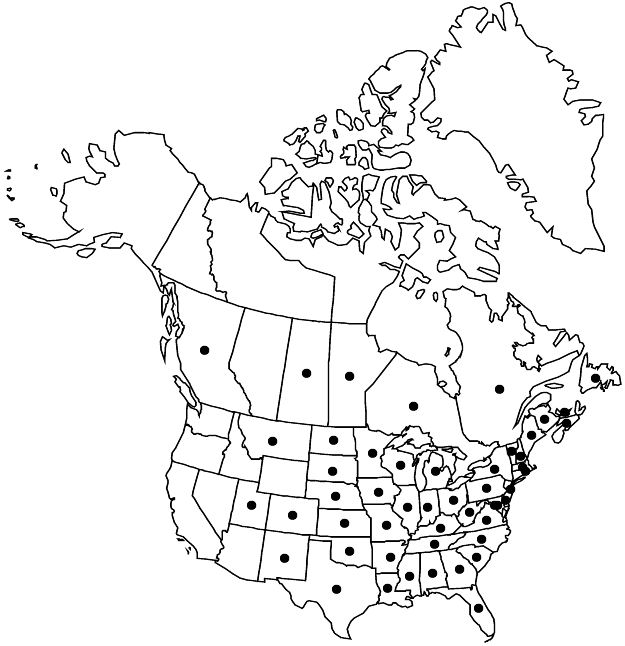Difference between revisions of "Viola sororia"
Hort. Berol. 1: plate 72. 1806.
FNA>Volume Importer |
FNA>Volume Importer |
||
| Line 81: | Line 81: | ||
|publication year=1806 | |publication year=1806 | ||
|special status=Endemic | |special status=Endemic | ||
| − | |source xml=https://jpend@bitbucket.org/aafc-mbb/fna-data-curation.git/src/ | + | |source xml=https://jpend@bitbucket.org/aafc-mbb/fna-data-curation.git/src/f6b125a955440c0872999024f038d74684f65921/coarse_grained_fna_xml/V6/V6_284.xml |
|genus=Viola | |genus=Viola | ||
|species=Viola sororia | |species=Viola sororia | ||
Revision as of 20:15, 24 September 2019
Plants perennial, acaulescent, not stoloniferous, 5–50 cm; rhizomes thick, fleshy. Leaves basal, 1–8, ascending to erect; stipules linear-lanceolate to broadly lanceolate, margins entire, sometimes glandular distally, apex acute; petiole 2–25 cm, pubescent or glabrous; blade green abaxially, unlobed, ovate or broadly ovate to reniform, 2–5 × 2–10 cm, not fleshy, base cordate, margins crenate to serrate, ciliate or eciliate, apex acute to obtuse or rounded, surfaces usually pubescent, rarely glabrous. Peduncles 3–25 cm, glabrous or sparsely pubescent. Flowers: sepals lanceolate to ovate, margins ciliate or eciliate, auricles 1–2 mm; petals light to dark blue- or dark purple-violet, reddish purple, or rarely white on both surfaces, usually white basally, lowest and sometimes lateral 2 purple-veined, lateral 2 bearded, lowest bearded or beardless, 15–25 mm, spur same color as petals, gibbous, 2–3 mm; style head beardless; cleistogamous flowers on prostrate to ascending peduncles. Capsules ellipsoid, 5–12 mm, glabrous. Seeds beige, mottled to bronze, 1.5–2.5 mm. 2n = 54.
Phenology: Flowering Mar–Jun.
Habitat: Dry to mesic habitats in woods, thickets, stream banks, moist prairies, pastures, disturbed ground, not in saturated soil
Elevation: 0–3000 m
Distribution

B.C., Man., N.B., Nfld. and Labr. (Nfld.), N.S., Ont., P.E.I., Que., Sask., Ala., Ark., Colo., Conn., Del., D.C., Fla., Ga., Ill., Ind., Iowa, Kans., Ky., La., Maine, Md., Mass., Mich., Minn., Miss., Mo., Mont., Nebr., N.H., N.J., N.Mex., N.Y., N.C., N.Dak., Ohio, Okla., Pa., R.I., S.C., S.Dak., Tenn., Tex., Utah, Vt., Va., W.Va., Wis.
Discussion
Viola sororia is similar to V. palmata in the high degree of phenotypic plasticity. The petal color is usually light to dark blue-violet. In V. sororia forma priceana (the Confederate violet) petals are grayish white with violet veins. Viola septentrionalis was recognized by N. L. Gil-Ad (1997) based on what he considered distinct capsule and seed morphology. His assumptions were based on one to four specimens. A. Haines (2011) alluded to the variability of V. sororia and indicated that a more northern form has often been called V. septentrionalis. He suggested that range-wide patterns of variation make it difficult or impractical to separate. We currently see no valid reason to recognize V. septentrionalis.
Viola floridana was recognized by D. B. Ward (2006) as distinct from V. sororia based on being glabrous except for scattered hairs on petioles.
Viola sororia reportedly hybridizes with V. cucullata (= V. ×bissellii House), V. hirsutula [= V. ×cordifolia (Nuttall) Schweinitz], V. pedatifida var. brittoniana (= V. ×insolita House), V. pedatifida var. pedatifida (= V. ×bernardii Greene), and V. sagittata var. sagittata (= V. ×conjugens Greene).
Selected References
None.